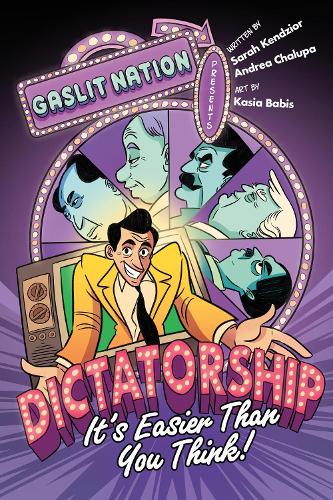Review by Frank Plowright
Andrea Chalupa and Sarah Kendzior co-host the Gaslit Nation podcast, and both have made a study of authoritarian regimes, in Chalupa’s case resulting in the film script for Mr. Jones, concerning the Ukranian famine of 1932. Don’t worry if you’ve not seen it, the story’s covered in passing here.
So how do you become a dictator? According to Chalupa and Kendzior you start by claiming to the masses that you’re on their side, and follow up by claiming mainstream news sources constantly lie to them, predominantly about who’s actually responsible for their troubles. Demonise any opponents, and encourage your supporters to do the same, but make sure you support any state-funded organisation concerned with protecting the law. It’s also useful to act as a martyr, claiming all sorts of groups are against you for pointing out the truth, while they always lie. Does it sound familiar in a modern day context? It’s certainly been a successful path historically.
What follows introduces the bells and whistles of symbolism, terror campaigns, packing the courts and foreign appeasement, all broken down into chapters of a few pages at a time, introduced by a host whose slimy personality is brilliantly characterised by Kasia Babis. It’s a strange decision to colour the entire book in shades of green and purple, but otherwise hers is confident cartooning delivering the information comprehensively.
Once the parameters of dictatorships are established, we’re taken on a global tour of examples and their atrocities. This is broader than the usual suspects, encompassing former Soviet states, and noting how authoritarian states survive the death of the authority. A quick stat is that 21 countries are featured as having had dictatorships in the last hundred years, including five of the largest in the world and two of Europe’s largest nations. This is without including Algeria, the world’s tenth largest country, whose dictatorship isn’t mentioned.
You’ll have noticed Donald Trump on the cover alongside Hitler, Putin and Stalin, and he’s referred to again and again as Chalupa and Kendzior point out how his tactics are the same as those used by numerous dictators. In his rambling, freeform speeches he’ll lie, constantly attack the press, demonise minorities, and display his martyr’s complex, while nepotism is prevalent in his organisations. He ticks so many boxes, and of course, still refuses to accept election results from 2020.
Despite the sardonic approach taken, reaching the end of this astute distillation of power hungry thugs you may well have lost all faith in humanity, because ordinary people are complicit. Dictatorships survive through spreading terror, a constantly reinforced false narrative, and relying on cowardly citizens denouncing their neighbours. A chapter proving the crimes of any repressive regime are always revealed in the end may not be a great comfort, especially when that end can be decades after power has been seized, and millions have died, been tortured and imprisoned in the meantime.
The USA has never had a dictator as such, but the final chapter equates the continuing suppression of minorities in the USA with dictatorial behaviour, and points out how that policy’s been exported worldwide. So how do dictatorships come about? A recurring factor is political indolence and ignorance where less extreme politicians support the extreme believing they’ll be able to resume control once their political opposites have been wiped out. The current cosy relationship between the right wing of the UK’s Conservative Party and the more extreme Reform is just such a situation.
A terrifying and informative warning, Dictatorship ought to be a school text book.







